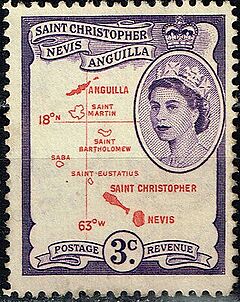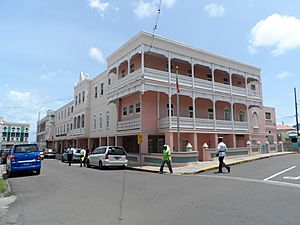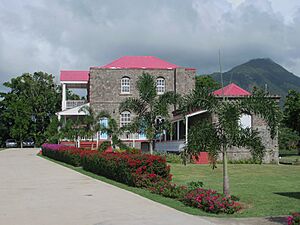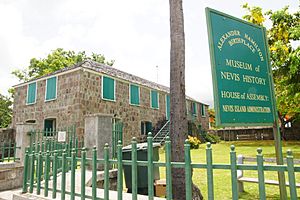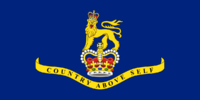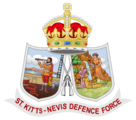Monarchy of Saint Kitts and Nevis facts for kids
Quick facts for kids King of Saint Kitts and Nevis |
|
|---|---|
|
Federal
|
|
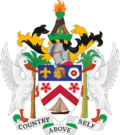
Coat of arms of Saint Kitts and Nevis
|
|
| Incumbent | |
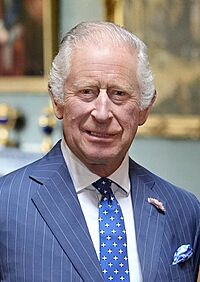 |
|
| Charles III since 8 September 2022 |
|
| Details | |
| Style | His Majesty |
| Heir apparent | William, Prince of Wales |
| First monarch | Elizabeth II |
| Formation | 19 September 1983 |
The monarchy of Saint Kitts and Nevis is a special way the country is governed. It means that a monarch (a king or queen) is the official head of state. This role is passed down through the family. Since September 8, 2022, King Charles III has been the monarch of Saint Kitts and Nevis. He represents the "Crown" of the country.
Even though King Charles III is also the monarch of 14 other countries in the Commonwealth of Nations, each country's monarchy is separate. So, he is officially called the King of Saint Christopher and Nevis. He and other members of the royal family do public and private duties for Saint Kitts and Nevis. However, only the King has a real role in the country's laws.
The King holds all the main power, but most of it is used by elected officials. These include members of parliament, government ministers, and judges. The King's power to do things like fire a prime minister is very important. But these powers are usually only used in special, emergency situations.
Today, the Crown helps make sure the government runs smoothly and fairly. It also acts as a neutral protector against anyone trying to misuse power. Most of the King's duties are carried out by his representative in the country. This person is called the governor-general of Saint Kitts and Nevis.
Contents
How the Monarchy Started
In 1623, Sir Thomas Warner came from England. He started the first successful English colony in the West Indies on Saint Kitts. French settlers also arrived in 1625. For a long time, Saint Kitts was shared between French and English colonists. In 1713, Saint Kitts became fully British. Even when the French captured Brimstone Hill in 1782, Britain got the island back in 1783.
Nevis was settled by the English in 1628. It quickly became one of the richest islands in the Antilles. Even though it faced attacks, its economy stayed strong until the mid-1800s.
Saint Kitts, Nevis, and Anguilla joined together in 1882. After being part of the West Indies Federation for a short time, they became an associated state in 1967. This meant they could manage their own internal affairs. However, Nevis and Anguilla were not happy with Saint Kitts having too much control. Anguilla even declared its independence in 1967. After some talks, Anguilla became directly controlled by Britain in 1971. Its link with Saint Kitts and Nevis was officially ended in 1980.
In 1982, a meeting was held in London to discuss independence. Despite some disagreements about Nevis, Saint Kitts and Nevis became fully independent on September 19, 1983. It became an independent country within the Commonwealth. Queen Elizabeth II became its head of state and Queen of Saint Kitts and Nevis.
Princess Margaret represented the Queen at the independence celebrations. She received a 21-gun salute at the airport. Thousands of people cheered for her. After the flag-raising ceremony, the Princess read a message from the Queen. She then officially handed over the country's new laws to the first Prime Minister, Kennedy Simmonds.
The Crown of Saint Kitts and Nevis
Saint Kitts and Nevis is one of fifteen independent countries. These are called Commonwealth realms. They all share the same monarch. But the monarch's role in Saint Kitts and Nevis is completely separate from their role in any other country. Even though they share the same person as their monarch, each Commonwealth realm is independent. The monarch is represented in Saint Kitts and Nevis by a viceroy, who is the governor-general.

Since Saint Kitts and Nevis became independent in 1983, the Crown has been both shared and separate. The monarch's role as King of Saint Kitts and Nevis is unique. It is different from his role as monarch of the United Kingdom or any other country. This means the monarchy is no longer just a British thing. In Saint Kitts and Nevis, it has become a national part of the country.
This separation is shown in many ways. For example, the King has a special title just for Saint Kitts and Nevis. When he acts as a representative of the country, he uses symbols of Saint Kitts and Nevis. These include the country's national flag and unique royal symbols. Also, only Saint Kitts and Nevis government ministers can advise the King on matters of the country.
In Saint Kitts and Nevis, the country's legal identity is called "His Majesty in right of Saint Christopher and Nevis." It is also known as the "Crown in right of the Government of Saint Christopher and Nevis."
The King's Title
In Saint Christopher and Nevis, the monarch's full title is: Charles the Third, by the Grace of God, King of Saint Christopher and Nevis and of His other Realms and Territories, Head of the Commonwealth.
Oath of Loyalty
People in important roles in Saint Kitts and Nevis swear an oath of loyalty to the monarch. This is a promise to be faithful to the King. The King also promises to govern the people of his realms fairly, following their laws and customs.
The oath of loyalty in Saint Kitts and Nevis is:
"I, (name), do swear that I will faithfully bear true allegiance to His Majesty King Charles the Third, His Heirs and Successors, according to law. So help me God."
Who Becomes Monarch Next?

The rules for who becomes monarch next are based on primogeniture. This means the oldest child inherits the throne. These rules are set by laws like the Succession to the Crown Act 2013. They also follow the Act of Settlement 1701 and the Bill of Rights 1689. These laws say that only natural, legitimate descendants of Sophia of Hanover can become monarch. They also state that the monarch cannot be a Roman Catholic. They must be in communion with the Church of England when they become King or Queen.
Even though these laws for Saint Kitts and Nevis are controlled by the Parliament of the United Kingdom, neither country can change them alone. They need all the other Commonwealth realms to agree. Saint Kitts and Nevis agreed to changes in 2013. The National Assembly passed the Succession to the Crown Act. This showed they accepted the changes made by the British Parliament.
When a monarch dies or steps down, the next person in line immediately becomes the new monarch. There is no need for a special ceremony to confirm it. A period of mourning follows, and flags are flown at half-mast. The governor-general usually announces the new monarch in Basseterre.
The King's Role in Government
The Constitution of Saint Kitts and Nevis sets up a system where the King and governor-general have legal roles. But they do not have political roles. The Crown is seen as a single body, with the monarch at its center. This means all government powers are officially held by the monarch. The government of Saint Kitts and Nevis is formally called His Majesty's Government of Saint Christopher and Nevis.
Most of the King's duties in the country are carried out by the governor-general. The governor-general is chosen by the King based on the advice of the prime minister of Saint Kitts and Nevis.
Running the Government
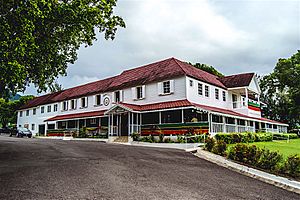
One of the Crown's main jobs is to appoint a prime minister. The prime minister then leads the cabinet. The cabinet advises the King or governor-general on how to use their powers. These powers cover all parts of government and foreign affairs. The King's and governor-general's roles are mostly symbolic. They represent the legal authority for all government actions. The cabinet decides how to use the King's special powers. These include declaring war, keeping peace, and directing the Saint Kitts and Nevis Defence Force. They also include calling parliament meetings and elections.
However, these special powers belong to the Crown, not to the ministers. The constitution allows the governor-general to use these powers alone in rare cases. This might happen if a prime minister needs to be dismissed, parliament dissolved, or a judge removed during a serious constitutional crisis.
Some duties are done only by the monarch, like appointing the governor-general.
The governor-general chooses the prime minister. This is the person most likely to have the support of the National Assembly. The governor-general also appoints the cabinet members. The King is kept informed by the governor-general about resignations and new appointments. He stays updated through regular messages from his Saint Kitts and Nevis ministers.
Dealing with Other Countries
The King's special powers also extend to foreign affairs. The governor-general approves treaties, alliances, and international agreements. Parliament's approval is not needed for these. But a treaty cannot change the laws of Saint Kitts and Nevis without a new law from Parliament. The governor-general also appoints Saint Kitts and Nevis's ambassadors. They also welcome diplomats from other countries. Passports are also issued in the governor-general's name.
Parliament's Role
The King, along with the National Assembly, makes up the Parliament of Saint Kitts and Nevis.
Parliament only meets when the King calls for it. No bill becomes law without the King's approval. The constitution also says that the governor-general appoints senators. One-third of senators are chosen by the governor-general based on the advice of the opposition leader. Others are chosen based on the prime minister's advice. The governor-general also calls, pauses, and ends parliament sessions. After parliament is ended, election notices are usually issued by the governor-general.
A new parliamentary session starts with the Opening of the National Assembly. During this, the monarch or governor-general reads the Speech from the Throne.
All laws in Saint Kitts and Nevis become official only when the governor-general gives Royal Assent in the King's name. Bills start with the phrase: "Be it enacted by the King's Most Excellent Majesty, by and with the advice and consent of the National Assembly of Saint Christopher Nevis and by the authority of the same as follows". The governor-general usually grants or withholds Royal Assent.
Courts and Justice
The King is seen as the "source of justice." This means he is responsible for making sure justice is served for everyone. The King does not personally decide court cases. Instead, judges do this in his name. In Saint Kitts and Nevis, crimes are legally seen as offenses against the King. Court cases for serious crimes are brought in the King's name, like The King [or Queen] versus [Name]. This also means the King cannot be charged with crimes in his own courts.
The highest court for appeals in Saint Kitts and Nevis is the Judicial Committee of the King's Privy Council.
The governor-general can also grant immunity from being charged with a crime. They can also use the King's special power to pardon offenses. This can happen before, during, or after a trial. This power to grant pardons and reduce prison sentences is explained in section 66 of the Constitution.
Monarchy in Nevis
Because of the country's constitution, the monarchy works separately on the island of Nevis. The Crown in Nevis is called the Crown in right of the Nevis Island Administration.
The governor-general appoints a deputy governor-general for Nevis. This person carries out the duties of the governor-general on the island. As the King's representative, the deputy governor-general lives at Government House in Nevis.
The King and the Nevis Island Assembly make up the Nevis Island Legislature. One-third of the Assembly members are chosen by the governor-general. This is done based on the advice of the opposition leader in the Assembly. Other members are chosen based on the advice of the premier of Nevis. All bills passed by the Nevis Island Assembly need the King's approval. The governor-general is also responsible for ending the Assembly's sessions.
The governor-general appoints the premier of Nevis. This is the person most likely to have the support of the Nevis Island Assembly. The governor-general also appoints other members of the Administration. This is done based on the premier's advice.
The Nevis Island Administration's job is to advise the governor-general on how to govern Nevis. The Administration is responsible to the Assembly for any advice they give to the governor-general.
Cultural Role of the Monarchy
Honours and Awards
The monarch is seen as the "source of honour" in the Commonwealth realms. This means the King, as Sovereign of Saint Kitts and Nevis, gives out awards and honours in his name. Most of these are given based on the advice of the Saint Kitts and Nevis government ministers.
In 1998, Saint Kitts and Nevis created its own national awards. These include the Order of National Hero, the Star of Merit, and the Medal of Honour. In 2005, the Order of St Christopher and Nevis was added. These awards are part of "The Order of Honour, Decorations and Medals." The governor-general is the President of this Order. A special committee suggests people for these awards to the prime minister. The prime minister then sends the recommendations to the governor-general. Award ceremonies are held by the governor-general at Government House.
The Crown and the Defence Force
The Crown is at the very top of the Saint Kitts and Nevis Defence Force. The St Edward's Crown appears on the Defence Force's badges and rank symbols. This shows that the monarchy is the source of authority. The governor-general acts as the commander-in-chief of the Defence Force.
The power to grant commissions (official appointments) in the Defence Force belongs to the King. It is used by the governor-general on his behalf.
The Crown and the Police Force
The national police force of Saint Kitts and Nevis is called "The Royal St Christopher and Nevis Police Force".
The St. Edward's Crown is on the Police's badges and rank symbols. This shows that the monarchy is the source of authority.
Every member of the Royal St Christopher and Nevis Police Force must swear loyalty to the monarch. This happens when they start their job. The oath of loyalty, under The Police Act, 2002, is:
"I, (name), do swear that I will well and truly serve Our Sovereign Lord the King in the office of Special Constable in the Federation without favour or affection, malice or ill-will, and that I will cause His Majesty's peace to be preserved, and will prevent to the utmost of my power offences against the same. So help me God!"
Royal Symbols
The main symbol of the monarchy of Saint Kitts and Nevis is the King himself. His framed pictures are displayed in public buildings and government offices. The monarch also appears on special stamps of Saint Kitts and Nevis.
A crown is also used to show the monarchy as the source of authority. It appears on the badges of the defence and police forces, postal workers, and prison officers.
God Save The King is the royal anthem of Saint Kitts and Nevis.
New citizens of Saint Kitts and Nevis must swear loyalty to the monarch and his future heirs.
-
The flag of the governor-general of Saint Kitts and Nevis, showing the St Edward's Crown.
Royal Visits
Visits in the 20th Century
Princess Margaret visited Saint Kitts in February 1955.
Queen Elizabeth II and her husband, the Duke of Edinburgh, visited Saint Kitts and Nevis in 1966. On February 22, the Queen held a special ceremony at Government House. They also attended a reception with about 700 people. Later, they watched fireworks from Basseterre Water Front. In Nevis, the Chief Minister gave the Queen a large map of Nevis. Prince Charles visited in June 1973. He opened the newly fixed Prince of Wales Bastion at the Brimstone Hill Fortress National Park.
Princess Margaret visited again in September 1983. She represented the Queen at the independence celebrations. The Queen and her husband visited again in 1985. A reception was held on their ship, HMY Britannia.
The Princess of Wales (Princess Diana) vacationed with her sons in Nevis in January 1993.
In September 1993, Prince Philip, Duke of Edinburgh visited the country. He was the Queen's personal representative for the 10th anniversary of independence.
Visits in the 21st Century
The Earl and Countess of Wessex visited in March 2012. This was to celebrate the Queen's Diamond Jubilee. They met with Governor-General Sir Cuthbert Sebastian and Prime Minister Denzil Douglas. The Earl unveiled a plaque for the Diamond Jubilee. He also officially named the Basseterre Valley Park as the Royal Basseterre Valley Park. They visited Brimstone Hill Fortress National Park and a children's hospital. They also attended a state dinner.
Prince Harry visited in 2016, the year of the Queen's 90th birthday. He arrived on November 23 and was welcomed by a military parade. He attended a youth rally at Brimstone Hill Fortress. There, he unveiled a dedication to the Queen's Commonwealth Canopy. Prince Harry then went to Nevis by boat. He visited a turtle conservation project on Lovers Beach. In the evening, he returned to Saint Kitts for a reception at Government House.
The Prince of Wales (now King Charles III) and the Duchess of Cornwall (now Queen Camilla) visited Saint Kitts and Nevis in 2019. They arrived in Basseterre on March 21 and met local people. At the National Museum, they learned about the country's history. They signed a scroll to mark their visit and the building's 125th anniversary. They then traveled to Nevis by boat. They were welcomed by masquerade dancers. At Brimstone Hill Fortress National Park, the Prince learned more about the area. The Duchess visited Hermitage Plantation House. She met local women and saw arts and crafts. In the evening, they attended a reception. The Prince of Wales announced new scholarships to mark the 70th anniversary of the modern Commonwealth.
Discussions About the Monarchy
In September 2022, Prime Minister Terrance Drew said his government wanted to become a republic. This means having an elected president instead of a monarch. In May 2023, Drew suggested that Saint Kitts and Nevis was "not totally free" with King Charles III as head of state. He said he would start public discussions about becoming a republic. He also supported payments for slavery.
A 2023 survey found that 52% of people supported keeping the monarchy. 45% preferred Saint Kitts and Nevis to become a republic.
List of Saint Kitts and Nevis Monarchs
| Portrait | Monarch's Name (Born–Died) |
Time as Monarch of Saint Kitts and Nevis | Full Name | Spouse | Royal Family | |
|---|---|---|---|---|---|---|
| Start | End | |||||
 |
Elizabeth II (1926–2022) |
19 September 1983 | 8 September 2022 | Elizabeth Alexandra Mary | Philip Mountbatten | Windsor |
| Governors-general: Sir Clement Arrindell, Sir Cuthbert Sebastian, Sir Edmund Lawrence, Sir Tapley Seaton Prime ministers: Kennedy Simmonds, Denzil Douglas, Timothy Harris, Terrance Drew |
||||||
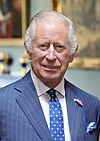 |
Charles III (b. 1948) |
8 September 2022 | present | Charles Philip Arthur George | Camilla Shand | Windsor |
| Governors-general: Sir Tapley Seaton, Dame Marcella Liburd Prime ministers: Terrance Drew |
||||||
See also
 In Spanish: Monarquía de San Cristóbal y Nieves para niños
In Spanish: Monarquía de San Cristóbal y Nieves para niños
- Lists of office-holders
- List of prime ministers of Elizabeth II
- List of prime ministers of Charles III
- List of Commonwealth visits made by Elizabeth II
- Monarchies in the Americas
- List of monarchies


